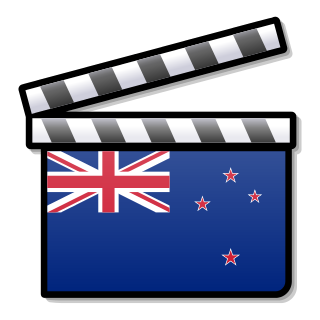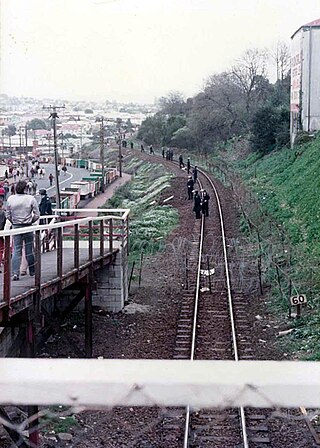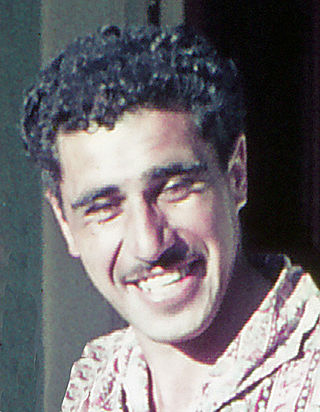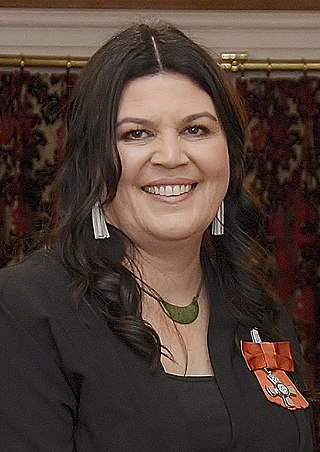
New Zealand cinema can refer to films made by New Zealand–based production companies in New Zealand. However, it may also refer to films made about New Zealand by filmmakers from other countries. New Zealand produces many films that are co-financed by overseas companies.

The 1981 South African rugby tour polarised opinions and inspired widespread protests across New Zealand. The controversy also extended to the United States, where the South African rugby team continued their tour after departing New Zealand.
Bruce Russell is a New Zealand experimental musician and writer.
The Polynesian Panther Party (PPP) was a revolutionary social justice movement formed to target racial inequalities carried out against indigenous Māori and Pacific Islanders in Auckland, New Zealand. Founded by a group of young Polynesians on 16 June 1971, the Panthers worked to aid in community betterment through activism and protest. Besides peaceful protests, they helped provide education, legal aid, and other social resources, such as ESOL classes and youth community programs. The group was explicitly influenced by the American Black Panther Party, particularly Huey Newton’s policy of black unity through his global call-to-action, as well as his ideology of intercommunalism. The movement galvanised widespread support during the Dawn Raids of the 1970s, and greatly helped contribute to the modern pan-Polynesian ethnic identity in New Zealand called Pasifika.

FMG Stadium Waikato is a major sporting and cultural events venue in Hamilton, New Zealand, with a total capacity of 25,800. Four areas contribute to this capacity: The Brian Perry Stand holding 12,000, the WEL Networks Stand holding 8,000, the Goal Line Terrace holding 800 and the Greenzone can hold up to 5,000 people. The capacity can be extended, however, by temporarily adding 5,000 seats to the Goal Line Terrace area. The stadium, owned by the Hamilton City Council, regularly hosts two rugby union teams:

Halt All Racist Tours (HART) was a protest group set up in New Zealand in 1969 to protest against rugby union tours to and from South Africa. Founding member Trevor Richards served as president for its first 10 years, with fellow founding member John Minto then serving as president until South Africa dismantled apartheid in the early 1990s.
The 1971 South Africa rugby union tour of Australia was a controversial six-week rugby union tour by the Springboks to Australia. Anti-apartheid protests were held all around the country. The tour is perhaps most infamous for a state of emergency being declared in Queensland.
In total, around 700 people were arrested whilst the Springboks were on tour.

John Minto is a New Zealand political activist known for his involvement in various left-wing groups and causes, most notably Halt All Racist Tours. A 2005 documentary on New Zealand's Top 100 History Makers listed him as number 89. As of 2011, he is involved with the protest group Global Peace and Justice Auckland and the Unite Union. He also wrote a weekly column for The Press and was formerly editor of the Workers' Charter newspaper.

Geoffrey John Chapple is a New Zealand author and journalist. He conceived and founded Te Araroa, a walking track the length of New Zealand.
Molesworth Street is located at the north end of the central business district of Wellington, the capital city of New Zealand. Leading from the northern end of Lambton Quay, central Wellington's main street, it is a northbound one-way street linking the CBD with Tinakori Road, and through it, with main routes north out of the city. The street was named for Sir William Molesworth, 8th Baronet, a prominent member of the New Zealand Company. There is another Molesworth Street in the Wellington metropolitan area, located in the Lower Hutt suburb of Taitā.
The 1994 South Africa rugby union tour of New Zealand was a series of rugby union matches played in New Zealand by the South Africa national team from June to August 1994. The team played 14 matches in total; 11 against provincial rugby teams and 3 against New Zealand. South Africa won 10 out of the 11 matches against provincial sides, losing to Otago. They lost their first two test matches against New Zealand national and drew the last test. The South Africa coach for the tour was Ian McIntosh. This was South African's first tour to New Zealand since the controversial 1981 South Africa rugby union tour, which was received negatively by New Zealanders due to South Africa's Apartheid regime at the time.
Merata Mita was a New Zealand filmmaker, producer, and writer, and a key figure in the growth of the Māori screen industry.
Rugby union is the national sport of New Zealand with the All Blacks as the national team. The All Blacks are made up of many races and cultures, and seven of the fifteen starters in the 2011 Rugby World Cup final were of Polynesian descent. However, although the national team has a long history of success, it also has on occasion been the subject of racial issues. On the international stage there has been controversy in the tours of and by South Africa, the most famous of which was the 1981 tour by South Africa. These tours drew much international criticism as many states were boycotting South Africa due to apartheid. On the domestic stage there have been issues of racism in the Super Rugby competition. There have also been some instances of racism in college rugby and club rugby. Racism is quite a serious human rights issue in New Zealand, which was highlighted in the Universal Periodic Review by the United Nations Human Rights Council.

Rugby union and apartheid had a complex and supportive relationship. From 1948 to 1994, international rugby relations with the country, and also the non-integrated nature of rugby within South Africa drew frequent controversy. South Africa remained a member of the International Rugby Board (IRB) throughout the apartheid era.

Rugby union has a long history in New Zealand. Today, New Zealand holds tier one status with World Rugby.

Shirley Yeta Horrocks is a New Zealand documentary filmmaker, specialising in social and art topics. She was appointed an Officer of the New Zealand Order of Merit, for services to documentary filmmaking, in the 2019 New Year Honours. The citation notes that "Horrocks is a leader in documentary films on the arts in New Zealand and has directed and produced documentaries for 35 years".

Rowley Habib, also known as Rore Hapipi, was a New Zealand poet, playwright, and writer of short stories and television scripts.

Ainsley Amohaere Gardiner is a film producer from New Zealand.

John Anthony Mercer is a New Zealand photojournalist.

Barry Noel Thomas is a New Zealand artist and film maker. He is known for creating 1min art films called rADz and for his activism art including in the 1970s planting cabbages in an empty building site in Wellington City.












